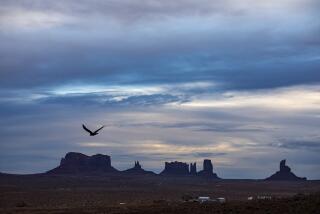Ruins Add New Pieces to Puzzle of Ancient Anasazi
- Share via
BOULDER, Colo. — Newly discovered evidence is shedding light on the movements of the Anasazi, a group of agricultural people who farmed the arid section of the Southwest from roughly AD 1 to AD 1300.
Researcher Stephen Lekson of the University of Colorado said he and his team linked three southern New Mexico ruins to the Anasazi and found evidence of a swift migration by entire villages of Anasazi around the year 1300.
Research indicates a major drought began in the region about 1150.
The Anasazi, a Navajo word meaning ancient ones, moved farther south than previously thought, and they abandoned their cliff dwellings in the Four Corners region much faster than originally believed, Lekson said.
The primary crops of the Anasazi were corn, squash and beans. They domesticated the turkey and some wild plant foods and hunted game to supplement their diet.
Some time ago, anthropologists rejected the popular theory that the Anasazi, now called Puebloans, abandoned their irrigated cornfields without a trace. They believe the Anasazi migrated south--gradually--because of drought, war or overpopulation.
But Lekson, the museum and field studies curator for the University of Colorado Museum of Natural History, said although the migration was gradual for many Anasazi, for others it was dramatic.
“It looks like whole villages may have picked up and moved south together, not just a smattering of families,” he said. “It sure looks like everybody leaves in a hurry.”
The drought doesn’t explain the whole story because the Anasazi, whom the Navajo and Hopi people claim are their ancestors, had survived worse ones, Lekson said.
Lekson said the evidence he found doesn’t directly support claims of cannibalism reported by other researchers, but it indicates “things were falling apart, and there was village-on-village violence.”
Researchers said in September that lab tests on ancient human excrement found among Anasazi ruins in the Four Corners region revealed evidence of human remains.
Lekson’s team reported finding three ruins that were similar to those at Mesa Verde, more than 200 miles to the south, on the west side of the Rio Grande River between the cities of Socorro and Truth or Consequences.
“Because of similarities in pottery and masonry construction, these sites stand out like sore thumbs,” Lekson said. At all three, the researchers found typical Mesa Verde black-on-white pottery.
At a site called Pinnacle Ruin, Lekson’s team found evidence that a village-sized group from the Mesa Verde region had settled there in the 14th century.
“It’s located next to permanent spring water and arable land and sandwiched between two mountain ranges on a defensible butte,” Lekson said. It was the ideal place for the Anasazi to settle, he said.
*
Mesa Verde on the Net: https://www.swcolo.org/Tourism/ArchaeologyHome.html
More to Read
Sign up for Essential California
The most important California stories and recommendations in your inbox every morning.
You may occasionally receive promotional content from the Los Angeles Times.













